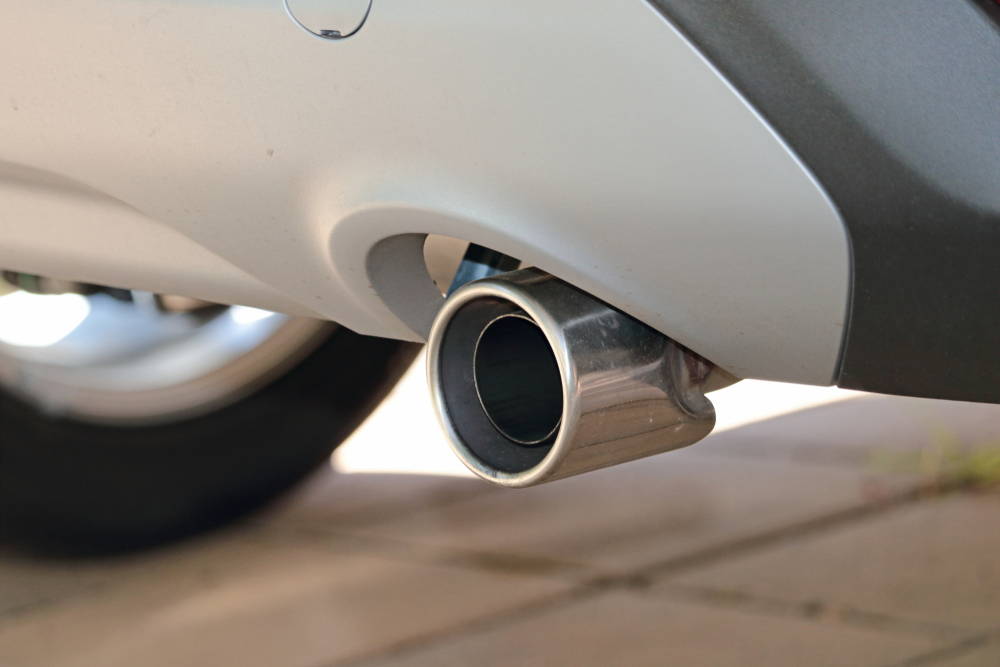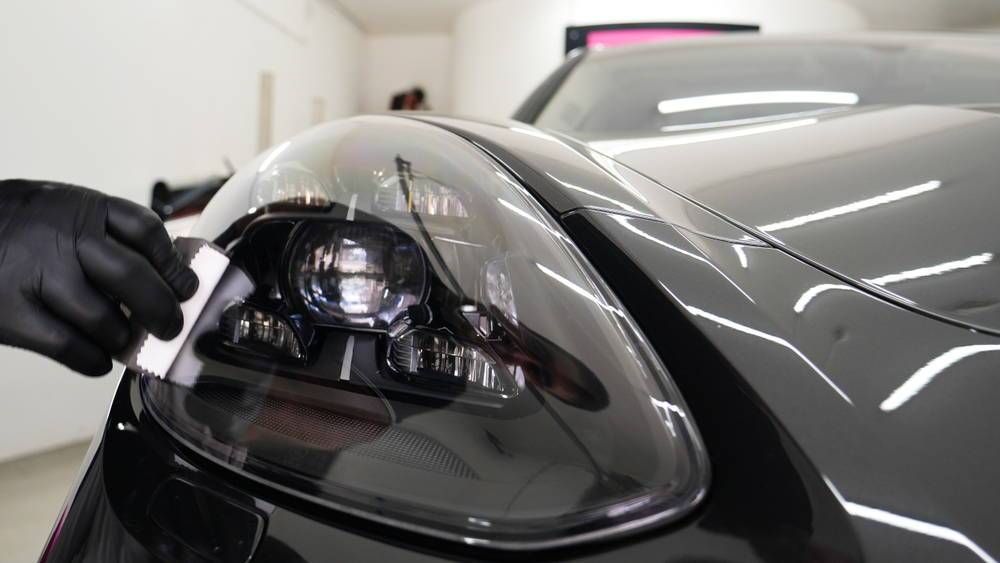Not all ceramic coatings are created equal.
Ceramic coatings are great for protecting your paint and clear coat against UV rays, chemical etching, mineral deposits, and dirt. They produce a brilliant glossy shine and make surfaces hydrophobic and super easy to clean.
You can apply them to body panels, plastic parts, trim pieces, rubber, glass, and all types of metals.
However, their application goes beyond just the cosmetic. Ceramic coatings have very real performance and durability benefits when used throughout the engine bay and exhaust system.
"The entire coating, including wheels, step bars, exhaust tips and chrome bumpers, took less than 3Oz with a very liberal application. Torque outshines and repels water way better the F-11. Six days in with 4 being heavy rain days in the 80's and parked in direct sunlight, you would think I had just detailed the truck. AWESOME!" - Michael H.
Quick Note Before We Start: Ceramic Coating vs. Ceramic Coating
When you hear “ceramic coating an exhaust system” it can mean two different things.
When we’re talking about the exhaust manifolds, that is the tough piece of metal that lets exhaust fumes flow straight from your engine to your exhaust pipes, they are most certainly talking about ceramic coating paint. That is a very high temperature coating.
When someone is talking about ceramic coating exhaust tips, they’re most likely talking about the typical kinds of ceramic coatings that automotive detailers love. Such as our popular Ceramic Spray product, great for getting shine and protection on the body of your car and it even works on exhaust tips!
Why Should You Bother Ceramic Coating Your Exhaust System?
The job of the exhaust system is to evacuate spent gases from the combustion as quickly as possible, emptying the cylinder and allowing a mixture of fresh fuel and air to enter during the intake stroke.
Obviously, the biggest performance factors for your exhaust are the diameter and layout of the pipes from the manifold all the way to the tailpipe.
One thing any exhaust system (new or old) can benefit from is improved heat management.
Internal combustion engines are not efficient; you get only 30-40% the energy from the combustion process at the flywheel, and that figure grows worse as performance demands increase.
The majority of the energy is wasted as heat, which exits through the exhaust system. Exhaust gas temperatures (EGT) usually sit at around 500 degrees F when the engine idles, and climb up to 1,200-1,400 degrees F at wide-open throttle. High performance and forced induction engines could see temperatures rise as high as 2,000 degrees F.
If you’ve seen glowing headers at the dyno, you know what we’re talking about.
Heat is the enemy!
Heat cycling metal components will cause them to weaken over time and accelerate corrosion. Exhaust manifolds, headers, and hot-side turbo housing are always covered in a thick layer of surface rust.
Metals, especially steel and cast iron, are great heat conductors. When the exhaust system absorbs the heat from the combustion gases, it radiates it out to other components in the engine bay.
The heat soaks through into the bolts and studs, causing them to rust and seize, turning a 30-minute removal into a full weekend project.
There are all sorts of plastic covers and tanks, wiring, electronic sensors, rubber hoses, belts, and boots in the engine bay. All these materials face accelerated degradation and ageing when exposed to heat. They dry out, harden, and eventually crack, unleashing a host of other problems.
This issue becomes more apparent in tightly-packed engine bays, where performance modifications have increased the amount of heat stress beyond what manufacturers have designed into the components.
Special, high-temperature ceramic coatings can help you manage that heat and trap it into the exhaust.
Improve The Heat Resistance
By coating your exhaust system with high-temperature ceramic paint, it will form a 2-3mm-thick layer of insulation over the parts. The coating keeps the heat sealed within the pipes, lowering surface and overall engine bay temperatures.
How much cooler? Reputable ceramic coating companies boast figures between 30% and 65% lower surface temperatures on coated exhaust components.
You can ceramic coat any part of your exhaust - the manifold/headers, hot-side turbocharger housing, downpipe, catalytic converter, X-pipes, and muffler.
Ceramic coating has the most noticeable effect on the hot side of the engine and the piston crown, but you can also apply it on the block, heads, valve covers, and even on the intake. You can also coat brackets and even existing heat shields already installed in the engine.
Improve The Performance And Efficiency of Your Exhaust System
Heat and pressure are always linked. If your exhaust headers are losing heat to the engine bay, the pressure in the system drops, as does the flow rate of spent gases.
This reduces the scavenging of the cylinder during the exhaust stroke, decreasing the overall efficiency of the exhaust system and limiting the performance of the engine.
If your turbo housing is radiating heat into the engine bay, it means less energy is being used for spinning the turbine and making boost. The efficiency of the turbocharger is reduced, increasing spool time and limiting top-end power.
If you coat your exhaust manifold/headers, the hot-side turbocharger housing, and downpipe, you’ll form a thermo-insulating barrier, keeping most of the heat within the pipes and allowing your exhaust to perform to its fullest potential.
Improve The Efficiency Of Your Catalytic Converter And Reduce Emissions
Catalytic converters only work when they reach operating temperatures - usually above 800 degrees F. That’s when the reactions of reducing NOx and unburned hydrocarbons can occur efficiently, resulting in less harmful tailpipe emissions.
Ceramic coating your exhaust will allow the catalytic converter to warm up and reach peak operating efficiency faster.
That said, keep in mind that sustained temperatures above 1,600-1,700 degrees F are detrimental and can burn through the catalytic converter, effectively blowing its contents out the tailpipe.
Increase Visual Appeal And Fight Against Corrosion
If you’ve ever disassembled a 10-year-old badly rusted exhaust system, you’ll know the struggle is real when you strip a nut or have to extract broken studs from the cylinder head.
It’s a huge pain in the ass that you can almost entirely mitigate by coating your exhaust manifold or headers.
Then, there’s the visual appeal. Rust is ugly. Period.
If you care about how your car looks on the outside, you should definitely care about your engine bay too. Ceramic coating paints come in a variety of colors and can leave either a matte or glossy finish. You can plan the color scheme of your engine bay and match your ceramic coatings to other colored components for a uniform look and feel.
Now who doesn’t just love a well-dressed engine?
Ceramic Coated Exhaust Tips Are Easier to Clean Off And Keep Shiny For Longer
Popular Spray On Ceramic Coating 'Ceramic Spray' Works BRILLIANTLY on Exhaust Tips
Ceramic Coating does not have to be difficult and tedious. Give our popular ceramic coating product a shot on your exhaust tips today!
The only part of the exhaust we can see on the outside is the tailpipe. Exhaust tips add a bit of flair to an otherwise purely functional component and help tie your exhaust system with the overall design of the vehicle.
The right exhaust tips can transform the rear end of your vehicle. However, to keep them looking clean and shiny requires spending significant time and effort in maintenance.
Hot exhaust gases will deposit soot onto the surface of the tailpipe. They’re still 500-1,200 deg F when they exit the tailpipe, so they bake all the soot, road dirt, and grime into a hard, thick layer.
This is just as hard to clean as brake dust on your aluminium wheels. However, once cleaned and polished, a good heat-resistant ceramic coating will help keep your exhaust tips clean and shiny for way longer.
You’ll still need to clean them, but with a proper ceramic coating, it’s as easy as wiping them down with a microfibre towel.
Can Ceramic Coating Survive The Heat? No - Not That Type of Ceramic Coating
Ceramics typically have very high melting points, low thermal conductivity, and great resistance to heat.
That said, the amount of heat a ceramic coating can take depends entirely on the product and its constitution.
- What kind of ceramic particles are there?
- What’s their concentration?
- What polymers are used to bond the whole thing together?
- What application and curing method is used to bond the coating?
Let’s get this out of the way: the ceramic coating you apply on your body panels as paint protection is not the same as the ceramic coating you apply on manifolds, headers, turbocharger housings, and other components of your exhaust system.
It doesn’t matter if it’s a spray formula, traditional nano-ceramic liquid product, DIY, or professional-install only - it’s not the same stuff. Paint protection ceramic coatings will not work at all if you put them on your exhaust.
Most paint protection ceramic coatings - even the high-grade products - are not reliable beyond 500 degrees F.
There are specialized coatings for wheels and brake calipers that are designed around the heat and brake dust emitted from the braking system. These are suitable for coating exhaust tips, where EGTs are the lowest.
For the actual manifold or headers, turbo, downpipe, and other components, you definitely need to use a specialized high-temperature ceramic paint. Depending on their grade, these can endure temperatures of up to 2,000 degrees F, which is to be expected from a high-strung performance motor.
How To Apply A Ceramic Coating On An Exhaust Tip
Applying a ceramic coating on exhaust tips isn’t that much different from doing so on aluminum wheels or brake calipers.
- Start by washing your car, or at least the work area around the exhaust tips.
- Use detergents to remove all soot, dirt, and grime from the exhaust tips. Depending on the case, you may need to bust out the brake cleaner and heavy-duty degreaser. Use a scratchy pad to strip the soot and residue off the exhaust tips. You can actually use our very own Decon Soap. It is strong enough to even remove previous coatings of ceramic coatings that you have applied in the past.
- Grab your favorite metal polish compound and a microfiber cloth and polish the exhaust tips. Spend as much time as you think is necessary to get a finish you like.
- Apply your ceramic coating. - We recommend the easy to apply spray on ceramic coating product 'Ceramic Spray'
- If it’s a spray-on ceramic coating, spray it onto the surface, work it in with a microfiber cloth, and give it a minute to flash off. Then, wipe down the remaining residue and leave it for a couple of hours to cure.
- If it’s a traditional ceramic coating, put a few drops on your applicator and work the product into your exhaust tips. Give it a minute or two to flash off and wipe off all the excess with a clean towel. Allow the product to cure for at least 24 hours before taking the car out of the garage.
How To Apply A High-Temperature Ceramic Coating To An Exhaust Manifold
Applying a ceramic coating to your exhaust manifold or other parts of your exhaust system is more involved and requires you to disassemble them from the vehicle.
- Unbolt the exhaust manifold or turbo housing. Pay attention to the condition of your nuts and bolts and try your best to keep them in one piece. The last thing you want is to break a seized stud and have to drill out the cylinder head or some other component. Use WD40 and heat if you need to.
- Sandblast the part. There is no other practical way of removing the thick layers of surface rust uniformly and without damaging the integrity of the component. Make sure to tape and cover the flanges and other machined surfaces.
- Bake the part. Put the part in an oven at 250-300 degrees F for 30 minutes. The heat will burn off any remaining oils, residue, and organic compounds. Use compressed air to blast off any loose debris before and after putting the part into the oven.
- Once the part has cooled to ambient temperature, apply your high-heat ceramic coating paint. Follow the manufacturer’s instructions on the application process.
- Make sure to also cure the ceramic coating according to the manufacturer’s instructions. Some coatings are cured simply by leaving them alone for a couple of days. Others only harden when you bake them in an oven, or install them and run the engine at a specific RPM to heat up and set the ceramic coating.
What Should You Ceramic Coat Next?
As we mentioned at the beginning of the article, you can ceramic coat pretty much everything in your car as long as you have the right product.
Do you need to ceramic coat everything under the hood? Probably not.
You should definitely do your exhaust headers, hot side of the turbo, and downpipe. Only use high-temp ceramic coatings specifically designed for exhaust applications.
Then, if you’re still worried about thermal stress on the components immediately adjacent to the hot parts of your engine bay, you can coat those with a weaker ceramic product, such as a spray or rubbing solution.
Of course, if you care about the look of your car, you should definitely ceramic coat your paint, wheels, trim pieces, rubber seals, and windows. For exterior pieces, you can use a ceramic coating spray like Ceramic Spray by Torque Detail.
Summary
Okay, what have we learned?
- You can ceramic coat pretty much everything in your car. (Get started today with Ceramic Spray by Torque Detail)
- Ceramic coatings are not created equal - different products have different applications throughout your vehicle. They are not interchangeable.
- Ceramic coatings can create real performance, efficiency, and durability benefits when properly applied.
- Only use high-temperature ceramic coatings on exhaust manifolds, turbocharger housings, downpipes, and other exhaust parts.
- Use a wheel and brake caliper ceramic coating for exhaust tips that still experience a significant amount of heat. These coatings are designed for medium-heat application and aggressive environments.
- Use regular paint protection ceramic coatings on exterior pieces and engine bay components not subjected to direct heat stress.







